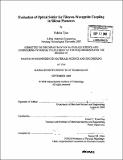| dc.contributor.advisor | Lionel C. Kimerling. | en_US |
| dc.contributor.author | Tjioe, Fidelia | en_US |
| dc.contributor.other | Massachusetts Institute of Technology. Dept. of Materials Science and Engineering. | en_US |
| dc.date.accessioned | 2009-04-29T17:29:27Z | |
| dc.date.available | 2009-04-29T17:29:27Z | |
| dc.date.copyright | 2008 | en_US |
| dc.date.issued | 2008 | en_US |
| dc.identifier.uri | http://hdl.handle.net/1721.1/45352 | |
| dc.description | Thesis (M. Eng.)--Massachusetts Institute of Technology, Dept. of Materials Science and Engineering, 2008. | en_US |
| dc.description | Includes bibliographical references (leaves 57-59). | en_US |
| dc.description.abstract | Copper interconnects have shown its limit to meet the bandwidth demand even in the short reach applications due to its increase power consumption, RC delay, EMI, crosstalk and other effects which are aggravated as dimension shrinks. Despite efforts to increase the system performance, e.g. by multicore technology, migration to photonics is unavoidable, as it can give much superior performance. The major impediment to the wide-use of photonics is the cost. Three major components that contribute to the cost escalation are the absence of integrable light source, fast modulator, and effective fiber to waveguide coupler. The latest issue was addressed in this work. Coupling light efficiently from fiber to waveguide is challenging because of the size (6[mu]m core diameter for fiber, 500nm for waveguide), shape, and refractive index (~1.5 for fiber, 3.5 for waveguide) differences. Optical solder was proposed as the gap filler in between the fiber and waveguide to account for the fabrication uncertainties. Together with an inverse taper structure patterned in the waveguide end, the coupling loss was much reduced from 7.5dB (direct butt-coupling), to less than IdB. Besides, optical solder increases the reliability of device, as it prevents moisture and dust from impairing the optically active area of the die. Its fabrication is also integrable with the current CMOS technology. The configuration allows high density optical interconnect at the edges of the die; together with the electrical interconnect spreading across the area of the chip. All these make this system very good potential coupling method to solve one of the major impediments above, and thus enable the widespread use of electronic-photonic ICs. | en_US |
| dc.description.statementofresponsibility | by Fidelia Tjioe. | en_US |
| dc.format.extent | 59 leaves | en_US |
| dc.language.iso | eng | en_US |
| dc.publisher | Massachusetts Institute of Technology | en_US |
| dc.rights | M.I.T. theses are protected by
copyright. They may be viewed from this source for any purpose, but
reproduction or distribution in any format is prohibited without written
permission. See provided URL for inquiries about permission. | en_US |
| dc.rights.uri | http://dspace.mit.edu/handle/1721.1/7582 | en_US |
| dc.subject | Materials Science and Engineering. | en_US |
| dc.title | Evaluation of optical solder for fiber-to-waveguide coupling in silicon photonics | en_US |
| dc.type | Thesis | en_US |
| dc.description.degree | M.Eng. | en_US |
| dc.contributor.department | Massachusetts Institute of Technology. Department of Materials Science and Engineering | |
| dc.identifier.oclc | 316801830 | en_US |
